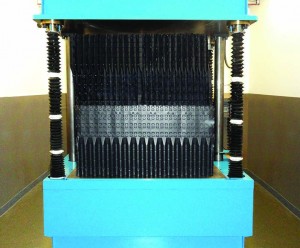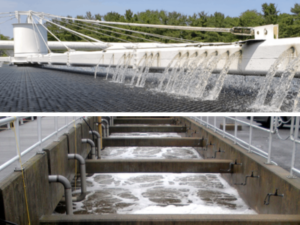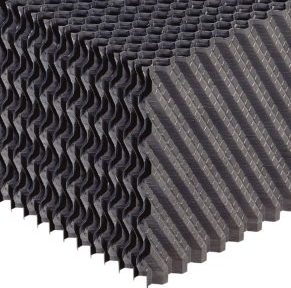One of the first factors to consider is how the packs are put together: glued vs. mechanically assembled (MA). In a nutshell, the strength requirements for the majority of standard applications in a cooling tower can be satisfied by both MA and glued packs. Check out our article for a detailed comparison of glued and MA packs.
Sheet thickness is determined by application. For example, a counterflow field-erected cooling tower servicing a power plant usually has a higher requirement for allowable pack force because service team members will be walking on the top of the fill packs to service nozzles. They also expect a longer life span in the harsh environment and they do not want the packs to be damaged. For these type towers we see 15mil and 20mil after-forming sheet thickness as the norm. Compare that to a factory-assembled counterflow cooling tower that is servicing a local school. In this case, the maintenance team won’t be walking or putting heavy loads on the fill packs. The comfort cooling application is less critical, allowing for cost savings by utilizing 8mil and 10mil after-forming sheet thickness as the norm. The thicker the sheet, the higher the expected crush strength as there is more polymer material to absorb an applied force.

Compression Test of Fill Media
One more aspect we need to look at is the sheet spacing within the pack. The best and most common example of this is to compare CF1200 to CF1900 fills. CF1200 has a 12mm flute measurement while the CF1900 has a 19mm flute measurement. Because the CF1200 has more sheets for the same size pack, using the same sheet thickness for both, the CF1200 will be able to distribute an applied load over more contact points and should provide for a “stronger” pack.
Last but not least, we need to consider the flute geometry of the packs. What we mean here is if the pack design is a cross-corrugated, offset flute, vertical flute or other design. Because of the geometry of the flutes within the pack design we get packs with inherently different strengths much like one would see in the difference between a LVL engineered wood beam and the same dimension beam made out of a single log. A cross-corrugated pack, like a CF1200 or CF1900, is inherently more resistant to crushing because of its crossing flute geometry versus the same pack designed in a vertical flute arrangement. Having a fill sheet design that crosses the flutes at opposing angles makes for more connection points and a stronger pack than one in which the flutes are all lined up in the same direction and installed in parallel.
Of course, with all if this said, the important design aspect that we can’t overlook is the fill support design and spacing. This is very important because the fill supports can vary in width and the supports can vary in distance between supports. Both of these factors dictate the bearing surface that the fill pack has to distribute the load and may be the governing design criteria for the minimum fill crush strength.
Now that we have looked at all of the variables that play into cooling tower pack strength there’s only one simple thing that an engineer or owner needs to know and ask for. Once a tower designer, engineer or owner decides what fill is needed for the application based on thermal performance, fire risk potential and fouling resistance, all they need to do is ask the manufacturer to provide crush strength data for that product to prove that the packs meet their requirement. Whether it’s a glued or MA product, the method of pack assembly should not be a limiting factor if the mechanical properties of the fill packs meet or exceed those that are required. Quite simply, ask the fill manufacturer for proof of performance and any reputable manufacturer will gladly provide their testing results.



The flute geometry of the packs sounds really important. If you are building a cooling tower you should definitely try to build it with the flutes crossing and not running parallel to each other. It would stink if the cooling tower broke because of something so simple. Thanks for informing us how to make cooling towers stronger.
The flute geometry does play a part in a fill packs crush strength (not cooling tower strength), however, not every application can utilize a cross corrugated product. The reason that other fill geometries exist is because of concern with fouling. While a cross corrugated fill can be structurally stronger as a new product due to the increased contact points, if the fill readily fouls from the circulating water, then the cooling tower will not perform thermally and the weight accumulation of fouling and scale could cause the tower support structure to become overburdened and fail. This article points out considerations when selecting a fill to meet design requirements and isn’t intended to convey that one type of product is superior to any other. One needs to look at fill selection as a balancing act of performance, fouling resistance, strength and flammability which leads to operational longevity. Thanks for your comment and taking the time to post on the article!